November 21, 2019
More broadcasters are streaming their contribution feeds than ever before. And as they look to improve their workflows, content has begun to move into the cloud. Learn how the right edge device for video encoding can bring your broadcast contribution workflows into the future.
By Mark Horchler



































